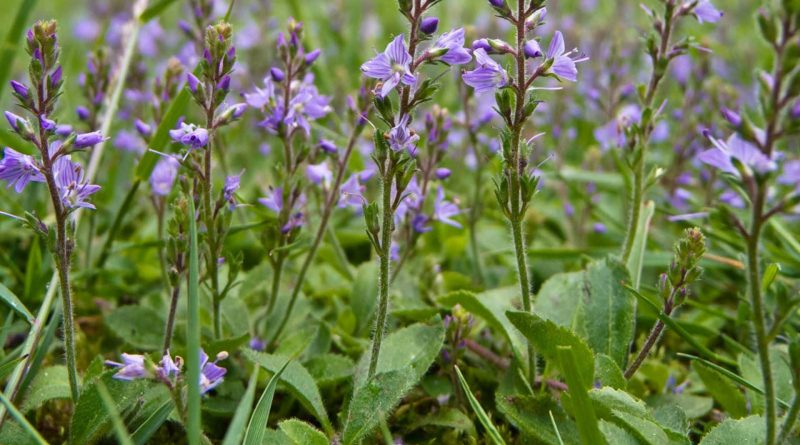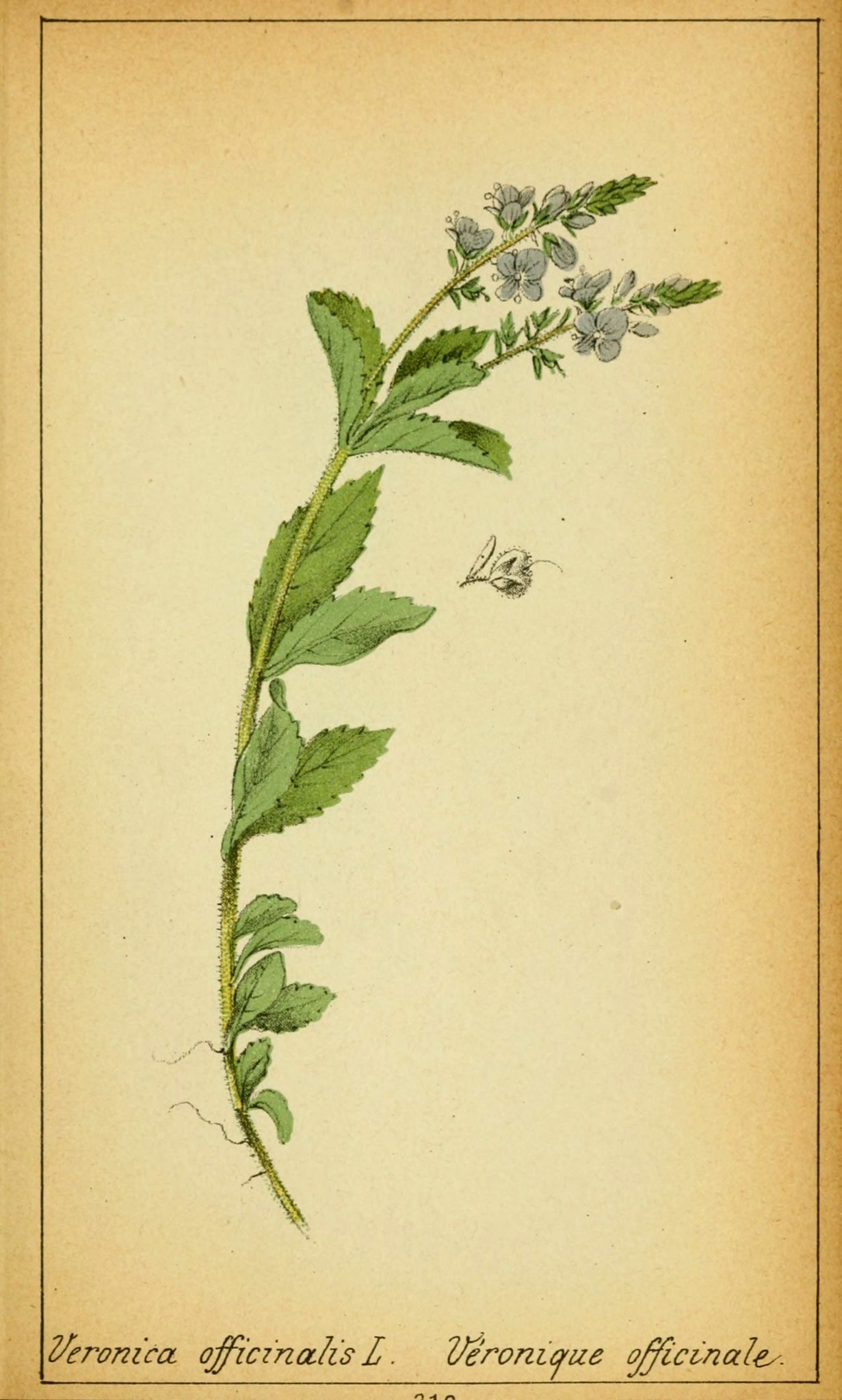Veronica officinalis
Veronica officinalis
The heath speedwell or common gypsyweed, common speedwell, Paul’s betony (Veronica officinalis L.) is a perennial plant belonging to the Plantaginaceae family and is also known as “Swiss tea” or “European local tea”, it is a very popular plant in ancient pharmacopoeia.
Systematic –
Veronica officinalis belongs to Domain: Eukaryota, Kingdom Plantae, Subkingdom Tracheobionta, Superdivision, Spermatophyta, Division Angiospermae or Magnoliophyta, class Magnoliopsida, Subclass Asteridae, Plantaginales Order, Family Plantaginaceae and species Veronica officinalis.
Etymology –
The genus name, was set in the eighteenth century by Linnaeus. This had already been adopted in England (1527) and France (1545), named after Italy’s Santa Veronica (1445-1497). Some sources believe instead that the name derives from Betonica for transliteration V to B, a name that belongs to a genre of the Labiatae family, others see a root in “verus” and “unicus”, or in a fanciful union between “vires” Latin and “nike” greek, assuming “victorious forces”. What seems likely is that the name of the genre in question has to do with Veronica, who, out of pity, wiped with a cloth face of Christ on the road to Calvary, the figure of the “holy” Veronica, which appears in the sixth Stations of the Cross, is not present in the four Gospels. Also popular in mystery plays at the end of the Middle Ages, it may derive its name from the mispronunciation of “real ikona”, the “true image.”
The specific name refers to the medicinal properties of the plant.
Geographic Distribution and Habitat –
Veronica officinalis is a plant native to Europe, north-east America and West Asia. Born in fertile and slightly humid soils. It is found abundantly in mountainous areas up to 2000 m above sea level, in the margins of the woods, in pastures and dry meadows.
Veronica, commonly also called Swiss Tea, Europe, Grass Tai, prefers dry soil and grows in forests, deforested places, next to hedges, fences, shrubs, ditches, along the trails and on the edge forest. It has a hairy stem from toothed leaves with silver reflections ending in clusters of tall flower spikes, which changes color from light blue to purple. At the touch easily it loses its leaves. The flowering period is between May and August.
Systematic –
Veronica officinalis belongs to Domain: Eukaryota, Kingdom Plantae, Subkingdom Tracheobionta, Superdivision, Spermatophyta, Division Angiospermae or Magnoliophyta, class Magnoliopsida, Subclass Asteridae, Plantaginales Order, Family Plantaginaceae and species Veronica officinalis.
Etymology –
The genus name, was set in the eighteenth century by Linnaeus. This had already been adopted in England (1527) and France (1545), named after Italy’s Santa Veronica (1445-1497). Some sources believe instead that the name derives from Betonica for transliteration V to B, a name that belongs to a genre of the Labiatae family, others see a root in “verus” and “unicus”, or in a fanciful union between “vires” Latin and “nike” greek, assuming “victorious forces”.
What seems likely is that the name of the genre in question has to do with Veronica, who, out of pity, wiped with a cloth face of Christ on the road to Calvary, the figure of the “holy” Veronica, which appears in the sixth Stations of the Cross, is not present in the four Gospels. Also popular in mystery plays at the end of the Middle Ages, it may derive its name from the mispronunciation of “real ikona”, the “true image.”
The specific name refers to the medicinal properties of the plant.
Geographic Distribution and Habitat –
Veronica officinalis is a plant native to Europe, north-east America and West Asia. Born in fertile and slightly humid soils. It is found abundantly in mountainous areas up to 2000 m above sea level, in the margins of the woods, in pastures and dry meadows.
Veronica, commonly also called Swiss Tea, Europe, Grass Tai, prefers dry soil and grows in forests, deforested places, next to hedges, fences, shrubs, ditches, along the trails and on the edge forest. It has a hairy stem from toothed leaves with silver reflections ending in clusters of tall flower spikes, which changes color from light blue to purple. At the touch easily it loses its leaves. The flowering period is between May and August.
Description –
Perennial, herbaceous, with pubescent stems, prostrate-ascending, long 10-40 (50) cm, rooting at the nodes. The leaves are opposite, equipped with short petioles, ovate-elliptic, finely toothed margin, pubescent. Axils of upper leaves develop racemes flowering erected (1 ÷ 3) at 15 ÷ 25 flowers, with glandular hairs elongated. The flowers (6-8 mm diameter) carried by short stalks are arranged axils of linear bracts, they have goblet divided into four lobes; the long corolla about twice the goblet, is composed of 4 irregular petals light blue or lilac or pinkish violet, paths from darker veins. Two mauve blue stamens are welded to the corolla. The ovary equipped with a long stylus (3-4 mm) and a stigma plate. The fruit is a capsule of 4 x 4 mm, triangular, obcordata, just smarginata, pubescent; seeds (15-20) lenticular, ellipsoids, yellowish brown.
Cultivation –
The cultivation of Veronica officinalis is not complex. Meanwhile, prefers the sunny places or semi-shady. It prefers loose soil, fertile and well drained. Watering should be regular but not too abundant by the vegetative growth.
If in pots you can use specific fertilizers for flowering plants slow release.
Multiplication is by seed in spring and by division of clumps in autumn.
The sowing of Veronica takes place in spring in containers placed in shady places. The seeds are very small, do not go underground, but scattered on the soil moist and lightly pressed with your hands. When the plants have developed 6-7 leaves thin out and are transplanted at a distance of about 20 cm moon on the other.
Veronica does not need to be pruned, but to stimulate new shoots and then new flowers is advisable to trim the branches withered.
Customs and Traditions –
Feverfew, sweating, expectorant, astringent, slightly diuretic, purifying, tonic. In the past it was used for external use in case you distrubi bronchial, arthritic, rheumatic, against stomach ache. For external use indicated in cases of eczema, burns, inflammation of the gums and in the treatment of minor injuries. The infusion of boiled tops is a great tonic for the facial skin. The use of its infusion was called the Swiss, became widespread in the late seventeenth century, in place of the Chinese, then very expensive; its spread came at the hands of the doctor pharmacologist Frederich Hoffmann.
Today, unfortunately, herbalists consider it obsolete. The bitter taste can lead some to appreciate how aperitiva herbal tea.
The pharmaceutical properties of Veronica officinalis are: flavoring, appetizing, digestive, anti-tussive, anti-inflammatory emollient. In the kitchen it can be used as a comfort drink to promote appetite and digestion.
Of Veronica officinalis gather the flowering tops of which have greater effectiveness those growing at the edge of the woods and under the oaks. This medicinal plant, handed down since the ancient times, is a good additive to the purifying herbal teas and, along with the fresh shoots of nettle, serves to completely cure chronic eczema. The weak and sensitive people tolerate well as a curative to the stimulating action of digestive stomach. also it heals the mucus of the stomach and intestinal disorders. Veronica produces a remarkable effect on the fragile nervous systems due to intellectual labors. A cup drunk in the evening, before bedtime, works wonders because of its tranquilizing effect. It promotes good memory and scatters sensations of vertigo.
Stirred to the root of celery, eliminate mood swings and melancholy. It works excellently even against jaundice and gravel, against joint pains, rheumatic and gouty.
When the Romans occupied Germany, got to know the indigenous population Veronica, medicinal plant appreciated more than any other among the Teutons. Indeed, it was called “the elixir of all evil” and is still commonly called ‘universal panacea’. In an old herbal book you read once, that even the Romans were convinced of his great healing power. When they wanted to make a special compliment to a friend or acquaintance, used to say that his good qualities were equivalent to glorificatissima Veronica.
During the Middle Ages, Veronica officinalis was known for its medicinal properties, known as herba Veronica majoris. In 1690 it was the subject of a treaty “Polchresta Herna Veronica” by Jhoannes Francus. In the nineteenth century it was impegata especially for infusions in place of tea, in France it was known as the “thé d’Europe”.
In France he was known as “Herbe aux Ladres” = grass lepers.
The use of its infused spread in the late seventeenth century, in place of the Chinese, then very expensive, it was called the Swiss, its spread came at the hands of the physician-pharmacologist Frederich Hoffmann.
Formerly used to treat a long list of diseases, from tuberculosis cough, fever leprosy; Today we know that these therapeutic properties, in fact do not exist.
Modalità di Preparazione –
La Veronica officinalis ha varie applicazioni; persino nei catarri bronchiali secchi la Veronica, come riportano alcuni testi del passato” ha saputo fare dei miracoli”. Come tisana pettorale ci si serve di un miscuglio di Polmonaria (volgarmente chiamata anche «Erba macchiata»), foglie di Farfara, Piantaggine e Veronica, in parti uguali, dolcificando con un po’ di miele, oppure si possono scottare le erbe con acqua bollente nella quale sia stato sciolto un po’ di zucchero candito.
Contro l’itterizia e i mali di fegato e della milza, viene raccomandata la seguente tisana:
50 g di radici di Tarassaco, 25 g di fiori di Cicoria, 25 g di Asperula e 50 g di Veronica. Mescolare bene. Sorseggiarne due tazze al giorno (per ogni litro d’acqua un cucchiaino da dessert colmo di questa miscela).
Dalla pianta in fiore si può ottenere anche un succo fresco, consigliabile nelle malattie croniche della pelle e soprattutto negli eczemi. Se ne prende un cucchiaino colmo, due o tre volte al giorno. La Veronica officinalis, negli antichi libri di erboristeria, viene raccomandata anche come erba vulneraria e consigliata per le ferite infiammate e a lenta guarigione, soprattutto nella zona dello stinco. Innanzitutto si lavano le ferite con una tisana; si coprono, durante la notte, con un impacco permeato di un infuso appena scottato e si fascia con un panno pesante.
Chi soffre di reumatismi e di gotta, dovrebbe provare una volta l’efficacissima tintura di Veronica, facilmente preparabile in casa. Questa tintura viene applicata esternamente sotto forma di frizione, mentre per uso interno se ne prendono giornalmente 15 gocce in poca acqua o nel tè.
In tutti i modi, bevendo ogni anno per un certo periodo di tempo la tisana di Veronica appena colta. Essa non solo diminuisce, ma previene anche l’arteriosclerosi e ridona, attraverso il suo effetto depurativo del sangue, una nuova elasticità al corpo.
Vediamo le modalità di preparazione –
• Tisana: 1 cucchiaino colmo da dessert per ogni 1/4 di litro d’acqua, scottare soltanto e lasciar riposare brevemente.
• Succo fresco: Si lavano le sommità fiorite e bagnate, si spremono con la centrifuga elettrica ad uso domestico. Indi si raccoglie il succo in piccole bottiglie, che si conservano nel frigorifero.
• Tintura: Due manciate di erbe fiorite e tritate si lasciano macerare in un litro di acquavite di grano a 38 – 40° al sole o in luogo riscaldato, per 15 giorni.
• Miscela di tisana: Un cucchiaino colmo da dessert su 1/4 di litro d’acqua; scottare soltanto e lasciare riposare brevemente.
Guido Bissanti
Sources
– Wikipedia, the free encyclopedia.
– Treben M., 2000. The Health from the Pharmacy of the Lord, tips and experiences with medicinal herbs, Ennsthaler Publisher
– Pignatti S., 1982. Flora of Italy, Edagricole, Bologna.
– Conti F., Abbate G., Alessandrini A., Blasi C. (ed), 2005. An annotated checklist of the Italian vascular flora, Palombi Editore.
Please note: Pharmaceutical applications and alimurgici uses are indicated for information purposes only, do not represent in any way a medical prescription; it accepts no liability on their use for therapeutic purposes, cosmetic or food.


